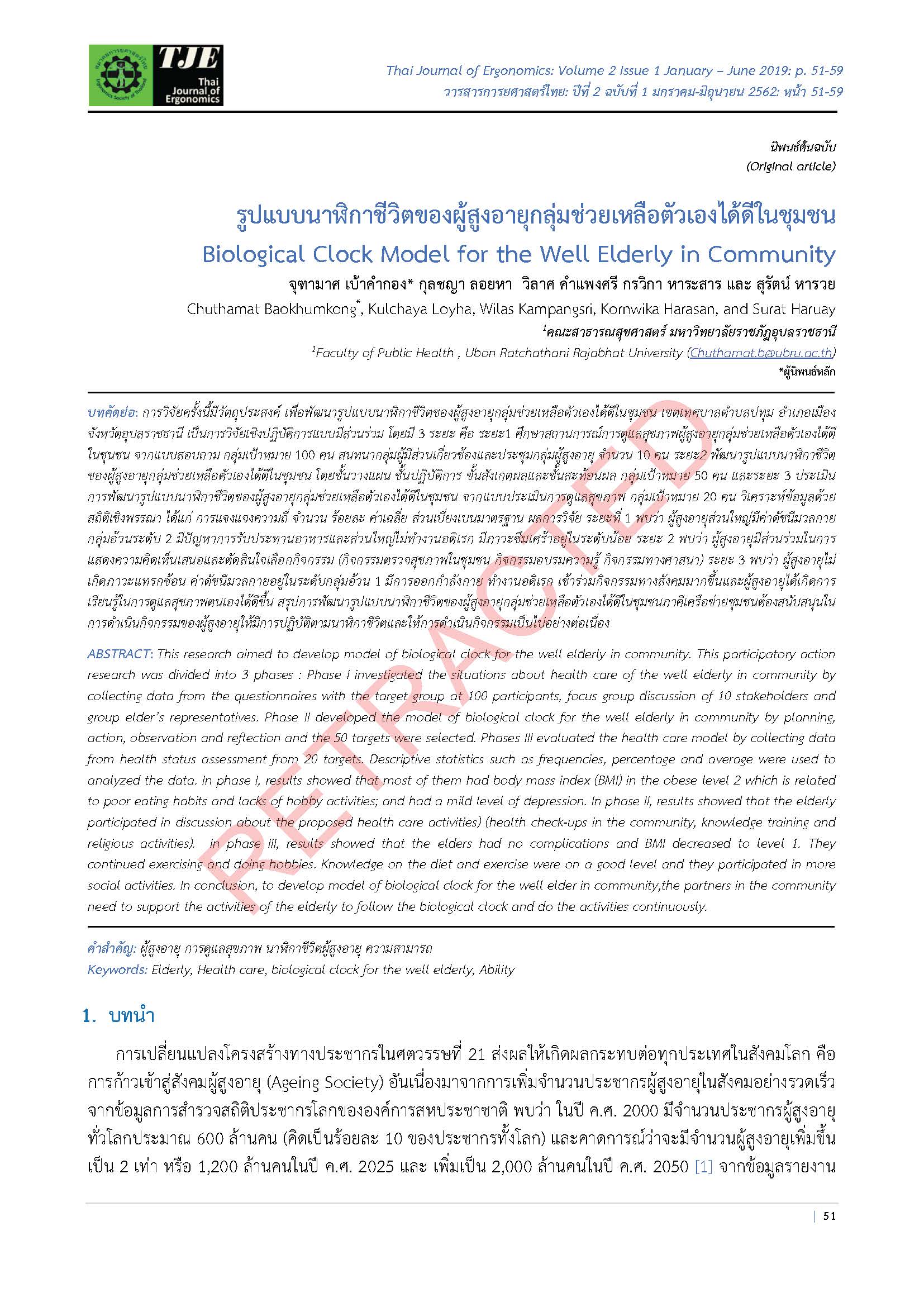Biological Clock Model for the Well Elderly in Community
Main Article Content
Abstract
This research aimed to develop model of biological clock for the well elderly in community. This participatory action research was divided into 3 phases : Phase I investigated the situations about health care of the well elderly in community by collecting data from the questionnaires with the target group at 100 participants, focus group discussion of 10 stakeholders and group elder’s representatives. Phase II developed the model of biological clock for the well elderly in community by planning, action, observation and reflection and the 50 targets were selected. Phases III evaluated the health care model by collecting data from health status assessment from 20 targets. Descriptive statistics such as frequencies, percentage and average were used to analyzed the data. In phase I, results showed that most of them had body mass index (BMI) in the obese level 2 which is related to poor eating habits and lacks of hobby activities; and had a mild level of depression. In phase II, results showed that the elderly participated in discussion about the proposed health care activities) (health check-ups in the community, knowledge training and religious activities). In phase III, results showed that the elders had no complications and BMI decreased to level 1. They continued exercising and doing hobbies. Knowledge on the diet and exercise were on a good level and they participated in more social activities. In conclusion, to develop model of biological clock for the well elder in community,the partners in the community need to support the activities of the elderly to follow the biological clock and do the activities continuously.
Article Details

This work is licensed under a Creative Commons Attribution-NonCommercial-NoDerivatives 4.0 International License.
References
Department of Economic and Social Affairs, Population Division. World Population Prospects The 2012 Revision. United Nations: WHO; 2013.
Regional Office for South-East Asia. Health of the Elderly in South-East Asia A Profile. New Delhi: World Health Organization; 2004.
โรงพยาบาลส่งเสริมสุขภาพตำบลปทุม. ภาวะสุขภาพประชาชน ปี 2559. อุบลราชธานี: สำนักงานสาธารณสุขจังหวัดอุบลราชธานี; 2559.
วิวัฒน์ เอกบูรณะวัฒน์. (2555). แรงงานสูงอายุ (Elderly Worker). ศูนย์อาชีวเวชศาสตร์และเวชศาสตร์
สิ่งแวดล้อม รพ.นพรัตนราชธานี. สืบค้นเมื่อวันที่ 10 ตุลาคม พ.ศ. 2560 จาก http://www.anamai.moph.go.th/occmed/indexarticle_elderly_worker.htm.
Mackey, M., Maher, C. G., Wong, T., & Collins, K. (2007). Study protocol: the effects of work-site exercise on the physical fitness and work-ability of older workers. BMC Musculoskelet Disord, 8, 9. doi:10.1186/1471-2474-8-9.
วิโชติ ผ้าผิวดี. การพัฒนารูปแบบการส่งเสริมสุขภาพผู้สูงอายุโดยภาคีผู้สูงอายุในชุมชนบ้านหนองเสือ ตำบลศรีสุข อำเภอสำโรงทาบ จังหวัดสุรินทร์. [วิทยานิพนธ์ปริญญาสาธารณสุขศาสตรมหาบัณฑิต สาขาวิชาการจัดการระบบสุขภาพ ]. มหาวิทยาลัยมหาสารคาม; 2555.
นิทรา กิจธีระวุฒิวงษ์. วิธีการวิจัยเชิงผสมผสานสำหรับงานสาธารณสุข. วารสารสาธารณสุขมหาวิทยาลัยบูรพา. 2555;7(2):130-152.
Qiu W, Dean M, Liu T. Physical and mental health of the homebound elderly: an overlooked population. J Am Geriatr Soc. 2010;58(12):2423-28.
สำนักส่งเสริมสุขภาพ กรมอนามัย. คู่มือการดูแลส่งเสริมสุขภาพผู้สูงอายุ. พิมพ์ครั้งที่ 5. นนทบุรี: กระทรวงสาธารณสุข; 2552.

